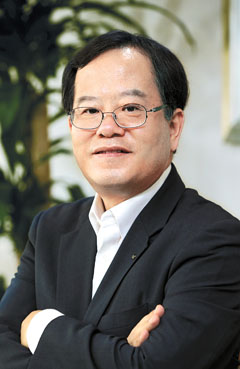Head of Kosdaq reflects on the index’s 20 years

Kim Jae-joon
Trading volume on the Kosdaq surpassed that of the main bourse Kospi this month, hitting record-high market capitalization. The index’s top players have also significantly diversified compared to the past, from mostly small and midsize IT companies to health care and game developers.
Kim Jae-joon, chairman of the Kosdaq Market Committee, sat down with Economist, a business magazine affiliated with the Korea JoongAng Daily, to reflect on the Kosdaq’s past 20 years and discuss the index’s future.
Q. What is your favorite moment since the Kosdaq’s launch?
A. It was when the Kosdaq index hit 2,834.40 on March 10, 2000, boosted by the tech bubble. There was a little setback, but it proved the information technology sector had become an important pillar of the Korean economy. The steep rise boosted the standing of the Kosdaq to investors and small and medium-size enterprises.
The stock exchange played an integral role in creating an ecosystem for venture capital. So now, it is seeing robust growth with initial public offerings. The number of newly-listed companies totaled 40 in 2013, but the figure increased to 69 in 2014 and 122 in 2015, the most since 2002.
In contrast, what was the most sour moment?
I think it was after the tech bubble era, after 2000. When the bubble burst, investor confidence dropped, so the index dipped below 400 on March 5, 2003, and went on to hit a record low of 261.19 on Oct. 27, 2008.
A series of speculation-driven events involving Codes Combine and Naturalendo Tech also ruined the Kosdaq’s reputation. The index also proved vulnerable to external shocks in January 2006, when the government resorted to enacting a circuit breaker on the Kosdaq market for the first time.
Over the last 20 years, the Kosdaq market has been heavily dominated by retail investors. What would be an ideal participation proportion of individual investors to institutional investors?
In the Kosdaq market, retail investors act as a driving force to generate market dynamics and, at the same time, create volatile market conditions. The heavy portion of 90 percent taken up by retail investors is something that we should resolve.
The market should have foreign, institutional and retail investors participating to create a dynamic yet stable market. We will feature derivatives linked with the Kosdaq so that institutions and foreign investors can buy them to hedge risks. I believe that the share of institutional and foreign investors, now at 15 percent, should go up to 30-40 percent.
Should the Kosdaq focus on local services or go global?
In the local market, the Kosdaq will focus on its essential role as a channel that provides funds to small and midsize companies. Still, we need to attract more foreign investors and global liquidity to the market. Seventy percent of foreign investment comes through Hong Kong and Singapore, so we will strengthen investor relations in those regions.
Where does the interest lie in investor relations?
We held investor relation events in Shenzhen [China], Hong Kong and Singapore. The interest in K-pop and K-beauty remains strong. The investors there also pinned higher hopes on Kosdaq-listed companies than on counterparts in the Kospi. I believe that the tech and bio companies on the Kosdaq will be able to find their edge as Korea’s industry landscape is undergoing a transformation.
Which companies are considered promising besides information technology and bio companies?
The focus of the Kosdaq moved from auto parts and information technology companies to high-tech industries including bio, health care and software. Celltrion, Medytox and Com2uS are leading the stock exchange.
In the coming years, high-tech companies with future-oriented growth engines are expected to be listed in droves. The most promising areas include artificial intelligence, fintech [financial technology], big data, virtual reality, autonomous cars and the Internet of Things, which are receiving a boost thanks to government support.
Do you have anything to suggest to financial authorities and the government?
The government announced an initiative in April to boost high-tech businesses as part of efforts to address the low-growth era. The plan is aimed at extending tax benefits if a certain entity makes investments on related facilities in the Internet of Things, smart car and bio sectors. Those areas are expected to grow significantly.
So we need the government’s policy considerations to make the Kosdaq more oriented toward the cited segments. The government should increase corporate tax benefits for start-ups and small and midsize companies. We need policies that are not designed for the stock operator Korea Exchange but for the listed companies.
How will you manage Konex, the country’s third index?
Konex serves as an incubator that supports innovative companies in their early stages. Above all things, we need to further spur the new listings by actively finding start-ups with great potential. We would like to do so in cooperation with the government. Later, we will help the Konex-listed companies safely move on to the Kosdaq market.
We also need to expand the base of investors, especially institutional and retail investors, thus increasing liquidity for the stock exchange. To support the market, the Kosdaq committee will jointly host investor relation events while publishing corporate reports.
What kind of relationship should the Kosdaq foster with the Kospi?
The Kosdaq should have a distinctive identity and sustainability. To be different from the Kospi, we will have more open rules for initial public offerings, reducing barriers for fund-raising.
BY KANG BYUNG-CHEOL AND PARK EUN-JEE [park.eunjee@joongang.co.kr]










with the Korea JoongAng Daily
To write comments, please log in to one of the accounts.
Standards Board Policy (0/250자)